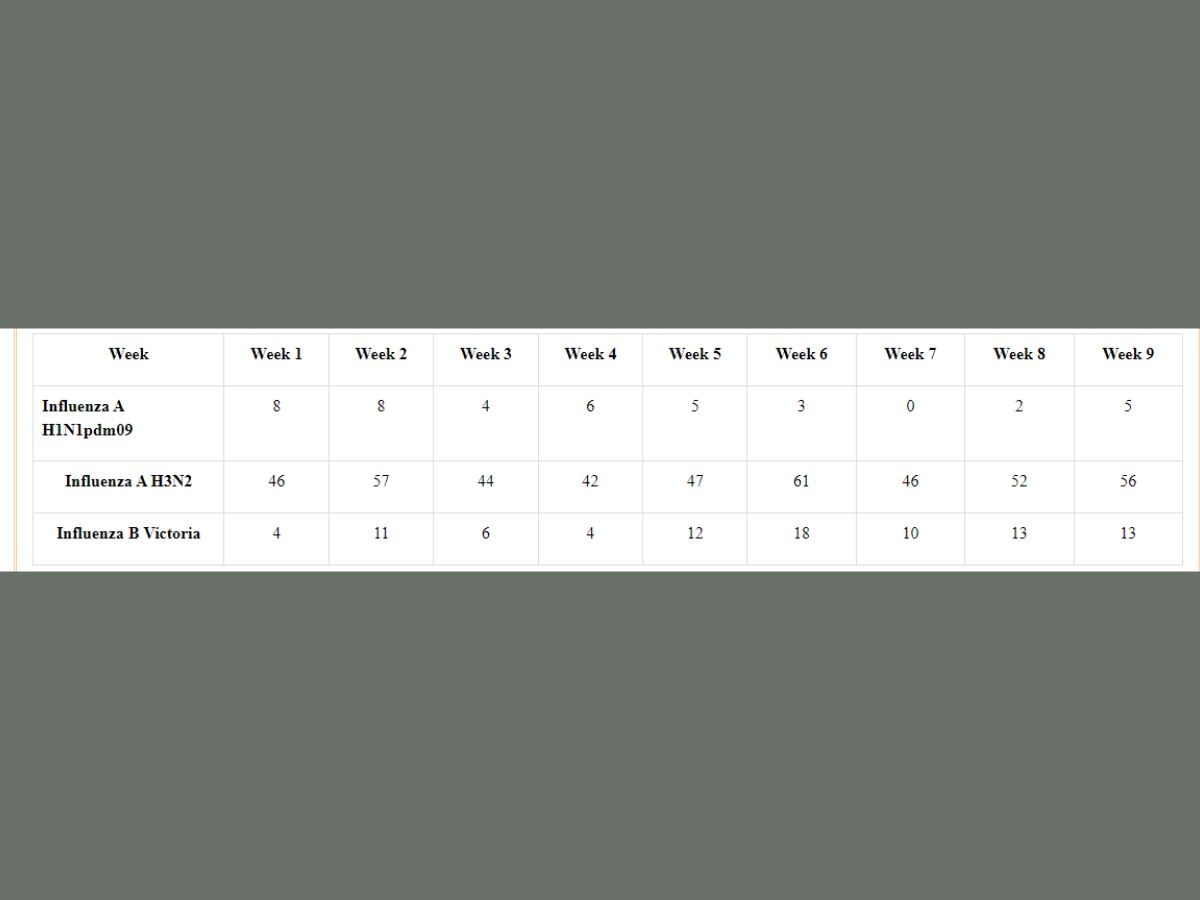Explained: What Is Influenza A Virus Subtype H3N2? Know Its Symptoms, Prevention And Treatment
H3N2 appears to cause more hospitalisations than other influenza subtypes, according to the Indian Council of Medical Research. The common symptoms caused by H3N2 are fever, cough, and breathlessness.

India reported its first two deaths from Influenza Virus A subtype H3N2 this week, in Karnataka and Haryana. The Union Ministry of Health released a statement on March 10, which said that the ministry is keeping a close watch on the morbidity and mortality of H3N2. The ministry also advised children, young adults and the elderly, especially those with comorbidities, to be careful and maintain precautions because they are the most vulnerable to seasonal influenza.
H3N2, a human seasonal influenza virus
Influenza viruses are of four types: A, B, C and D. Seasonal epidemics of disease in people, also known as flu season, are caused by Influenza A and B viruses. Seasonal influenza refers to the acute respiratory infections caused by influenza viruses. The only influenza viruses known to cause flu pandemics, or global epidemics of flu disease are Influenza A viruses.
When a new and different influenza A virus emerges that infects people, has the ability to spread efficiently among people, and against which people have little or no immunity, a pandemic can occur, according to the Centers for Disease Control and Prevention (CDC).
On the basis of two surface proteins, hemagglutinin (H) and neuraminidase (N), Influenza A viruses are divided into different subtypes. So far, 18 hemagglutinin subtypes and 11 neuraminidase subtypes have been identified. There are more than 130 Influenza A subtype combinations in nature.
Since there is a tendency for "reassortment", or the process of swapping gene segments, in Influenza viruses, there is a possibility that several other combinations exist, but have not been identified.
When two influenza viruses infect a host at the same time and swap genetic information, reassortment can occur.
Influenza A subtypes H1N1 and H3N2 are the two Influenza A strains that routinely circulate in people.
In India, the cases of seasonal influenza increase from January to March, and in the post-monsoon season.
According to India's health ministry, cases of seasonal influenza are expected to decline from March end.
In India, a structured surveillance network of 28 sites, which includes 27 Department of Health Research (DHR)-Indian Council of Medical Research (ICMR)'s Virus Research & Diagnostic Laboratories, and India's National Influenza Centre (WHO-NIC) at ICMR-National Institute of Virology, Pune, is conducting an integrated surveillance of influenza-like illness (ILI) and severe acute respiratory illness (SARI) for the detection of human influenza viruses and SARS-CoV-2.
The surveillance network monitored the viruses Influenza A H1N1pdm09, Influenza A H3N2, and Influenza B Victoria, for a period of nine weeks, from January 2 to March 5, 2023.
Since the beginning of 2023, Influenza H3N2 has been the predominant subtype among the samples testing positive for influenza.
In weeks 1, 2, 3, 4, 5, 6, 7, 8, and 9, the number of cases of influenza caused by H3N2 were 46, 57, 44, 42, 47, 61, 46, 52, and 56, respectively.

Symptoms of Influenza A H3N2
H3N2 appears to cause more hospitalisations than other influenza subtypes, according to ICMR.
Of the patients hospitalised due to severe acute respiratory illness caused by H3N2, about 92 per cent had fever, 86 per cent had cough, 27 per cent experienced breathlessness, 16 per cent had wheezing, 16 per cent showed clinical signs of pneumonia, and six per cent experienced seizures.
This means that the common symptoms of H3N2 infection are fever, cough, breathlessness, and wheezing, while pneumonia and seizures are rare symptoms.
According to ICMR, 10 per cent of the patients with severe acute respiratory infections affected by H3N2 required oxygen, and seven percent needed Intensive Care Unit (ICU) support.
According to Dr. Sandeep Budhiraja, Group Medical Director - Max Healthcare & Senior Director - Institute of Internal Medicine, H3N2 is causing symptoms which are slightly different and more severe than what was seen in previous years.
“Lots of patients are complaining of persistent coughs or bouts of cough which keep going on for many days, sometimes even for weeks after the flu settles. Even in the post-viral phase, lots of people have prolonged fatigue, weakness, tiredness, mental fogging, and inability to work and concentrate,” Dr Budhiraja said.
According to Dr Budhiraja, the feature of H3N2 is that it triggers a certain type of reaction or inflammation in the upper airways or sometimes even in the lungs, partly because it may be allergic or inflammatory in nature.
“Normally, fever, cough, and cold, body aches settle down in 3-5 days. In the present scenario, other symptoms are settling down but the dry hacking bounds of the cough continue,” Dr Budhiraja said.
How is H3N2 spread?
H3N2 is spread through droplets which contain the virus. If a person comes in close contact with someone who has been infected by H3N2, and inhales the aerosols exhaled by the infected person, the healthy person can also become infected.
Sneezing and coughing can release droplets consisting of the virus. Also, if a person touches a surface on which the virus is present, and then directly touches their nose or mouth, they could be infected with H3N2.
According to Dr. Raj Kumar, Senior Consultant, Internal Medicine, Indian Spinal Injuries Centre, changes in temperature and humidity, pollution and weather changes can increase one’s susceptibility to H3N2 infection.
“Changes in temperature and humidity can also affect the survival and transmission of viruses, making them more aggressive. Persistent coughing can be triggered by pollution, with particulate matter, irritating gases, and mixed pollutants having been linked to an increase in coughing and wheezing. In addition, changes in the weather can often lead to the production of mucus,” Dr Kumar said.
Who is at risk for H3N2 infection?
According to Dr Kumar, people with multiple underlying health-related conditions or weakened immune systems are more susceptible to developing severe symptoms due to seasonal influenza infection, and may take longer to recover from the illness. He also said that people who have been infected by Covid-19 variants have a compromised immune system.
“H3N2 may be more severe because of the fact that in the last three years, people were using masks extensively and this virus subtype could not enter the body. Hence, there was a lack of adequate antibodies to fight against this. With reduced or no masks now, the virus is entering people’s bodies. Due to compromised immunity against it, people are facing the long-lasting effects of the virus. This compromised immune system probably is making people more vulnerable towards viral infection. This is especially witnessed during the changing season, which can further affect the immune system, thus resulting in infections being more aggressive and long-lasting,” Dr Kumar said.
How to prevent H3N2
H3N2 infection can be prevented by wearing masks, avoiding crowded places, covering mouth and nose while sneezing and coughing, avoiding touching eyes and nose, especially after touching an external surface, drinking plenty of fluids, and taking paracetamol for fever and body ache.
Also, people must avoid shaking hands, must not spit in public, should not eat together sitting close to others, and must not take antibiotics or other medicines without consulting a healthcare professional.
Vaccination is the most effective way to prevent seasonal influenza infection. When the circulating viruses are well-matched with viruses contained in vaccines, an influenza vaccine is the most effective.
A trivalent influenza vaccine includes two subtypes of Influenza A virus, and one Influenza B virus subtype. Quadrivalent vaccines include all these viruses, along with another Influenza B virus subtype.
According to Dr Kumar, lifestyle changes, rest and hydration are important to prevent H3N2 infection.
“If one’s cough is caused by a viral infection, rest and hydration can provide relief. However, if the cough persists for over a week or is accompanied by other symptoms such as chest pain or difficulty breathing, it is crucial to seek medical attention. Pollution can exacerbate asthma, and the use of high-quality inhalers can aid in managing it. Lifestyle changes such as avoiding acidic or spicy foods and taking antacid medication if required can also assist in addressing acid reflux-related coughs.” Dr Kumar said.
How can H3N2 be treated?
The World Health Organization (WHO) recommends the drug oseltamivir for the treatment of seasonal influenza. Oseltamivir is made available through the public health system free of cost.
People who do not belong to the high risk group are administered symptomatic treatment
However, if people have severe or progressive clinical illness due to seasonal influenza infection, they are prescribed oseltamivir, a neuraminidase inhibitor, ideally within 48 hours following symptom onset.
The WHO recommends treatment for a minimum of five days. If a person has asthma, he or she can be given corticosteroids.
“In asthmatic people, airways become hyper-responsive to the viruses that trigger asthma-like situations. This gives them bouts of cough. These patients have to be treated with a combination of anti-allergic and asthma-like medications which basically help relax the airways and are sometimes given steroids which are more potent anti-inflammatories to reduce the swelling in the airways. Since they do respond to these medications, we can say that this is the virus that is triggering these effects in the upper airways,” Dr Budhiraja said.
Check out below Health Tools-
Calculate Your Body Mass Index ( BMI )
Calculate The Age Through Age Calculator







































